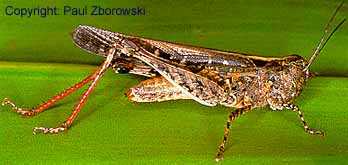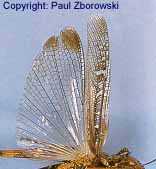Adult description 10 of 15


Size: Females 25 to 35 mm, males 20 to 25 mm.
Adult Description: Colour usually dark brown even approaching black. In profile the head is level to slightly raised from the thorax which has a central ridge. The dark mottled wings have a darker spot at the end. Hind legs with a diamond shape on the upper femur and red tibia. Hind wings with a smoky tint with a darker spot at the end that is more of a general smudge than a distinct spot. No throat peg.
Confusion with Australian plague locust: Easily confused. It has a slight dark spot at the wing tips and red tibia. Also it is a similar size and shape. However, individuals do not turn to face the observer on landing from short flights - a habit of the plague locust easily recognised in the field.
Unique features: The combination of the thorax not being saddle shaped in profile, the tip of the hind wing having a general smudge and not a dark spot, with a stouter and darker coloured body.
Further information on this species: Description of nymph
